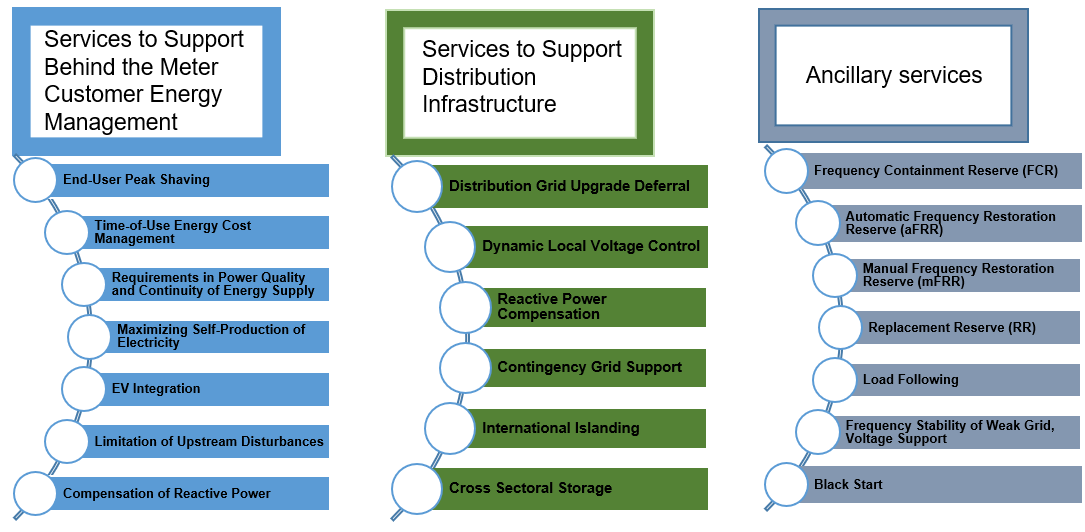How Flexibility Can Support Power Grid Resilience
Written by Irina Oleinikova
As zero operational-cost variable Renewable Energy Sources (RES) are foreseen to dominate the future energy mix, the abundance of green electricity will allow the replacement of fossil fuels in sectors such as heating, cooling, industrial processes, and transport. The intermittency of such energy resources implies significant systemic requirements for flexible solutions; thus, developments of the energy sector in general, and the power system in particular, instigate significant innovation activities in the fields of power system flexibility. Concurrently, complexities and interdependencies of system components and multitude of actors increase the risks of service failures, raising the demand for stronger and more agile resilience means and countermeasures. This article discusses the question, “How can flexibility support resilience?”, considering the increased societal needs of a secure electricity supply.
The impacts of global warming are beyond dispute1. The variability and uncertainty of power generation through RES and the consumers' increasingly proactive role in the power system operation complimented by their expanding technology options (e.g., solar PV, plug-in electric vehicles, etc.), drive the need for higher power system flexibility. In this context, we define flexibility as the modification of generation injection and/or consumption patterns in response to an external signal (price or activation) in order to provide a service within the energy system2. Flexibility could be provided by the system´s supply side (DER, aggregators, microgrid owners, etc.), network side, demand side, and storage availability (Figure 1).

Figure 1. Flexibility resources in power systems
Power system resilience reflect the impact of severe events (such as climate change caused threats, cyber security) and is an overarching concept, covering the whole spectrum of the power system from design and investment decisions to planning, operations, maintenance, and asset management functions. As such, the concept of power system resilience applies to the planning time frame that looks to build resilience into the future network, as well as the operational time frame, in which security is managed by optimizing the inherent resilience of the existing power system.
Flexibility concerns the power system's ability to manage changes, with flexibility features able to improve the resilience characteristics of the broader view system of systems, provided that they are integrated in grid planning, in defence plans, and properly evaluated in the energy market design. Flexibility capabilities need to be considered from the planning stage, using a holistic approach aimed at grids to be flexible and resilient by design. Flexibility resources can also facilitate the restoration process by exploiting distributed black start capabilities including sector-coupling, which adds a new dimension to the necessary interactions pattern between electrical TSOs and DSOs, with utilities from other sectors. Power system planning for the future grid must embrace a wide range of network and non-network options to create operational flexibility options, including more active demand management techniques and customer-sensitive smart load shedding procedures depended on the source availability or even market based.
The next level of flexibility is seen as being fully deployed and utilized for operation and planning of the power system, being integrated in procedures for long-term planning as well as in tools for stability support. The integrated dependency of flexibility directly impacts the resiliency of the power system, thus flexibility solutions intended to provide resilience support must be rigid and secure to provide the trust required for operation and planning.
Contributing to this, the European Climate Pact was launched to engage citizens, organizations, and all parts of society in climate action, by inviting people, communities, and organizations (here and after customers) to make climate-conscious choices and positively change their consumer behaviour3. Hence, the local dimension, in which consumer actions are actively considered as part of electrical system operation, has recently and is increasingly considered essential due to the power sector’s new framework4. Recognizing local flexibility resulting from the behaviour of consumers that already exist for active demand-side participation in the energy market is indisputable, yet it also requires further attention as the need for distributed flexibility becomes more ubiquitous. In response to this, the utilization of the in-house flexibility provided at the residential level via solutions such as creative demand-side management, storage utilization, can be included to effective operation for both transmission and distribution networks. Here, demand-side flexibility (DSF) refers to enabling final customers to become active in the market but also to system operators to make the best use of this flexibility to ensure efficient system operation5.
In addition to consumers, the DSOs and TSOs have a crucial role and interest. They are responsible for ensuring that the electricity in the system can flow safely and reliably between their grid users. From their perspective, DSF can safeguard a continuous availability of network capacity, reducing loads on energy grids and, thereby, can be an alternative for (short-term) grid reinforcement and/or construction of new electricity grids (including off-setting significant investments). Technically, it is possible to solve operational challenges, for instance, the problem of grid capacity through consumer DSF; the increased use of smart meters at customer premises enables thereby enabling enhanced network observability in the distribution grid. More specifically, measurements by the smart meter can be used for real-time flexibility assessment. Despite these opportunities, several issues should be addressed to unlock the potential of demand-side flexibility. The main issues are:
- The lack of customer awareness about what opportunities there are to engage in demand-side flexibility.
- The increase in the amount of available flexibility from the demand that lacks the operation strategy.
- The products traded in different markets (e.g., frequency regulation markets for Frequency Containment Reserves (FCR), automatic Frequency restoration reserve (aFFR), and manual replacement Reserves (mFFR) are incompatible with the actual capabilities of some technology
- The national legislation, organizational, and governance mechanisms.
The flexibility opportunities are constantly evolving due to the development of new energy technologies and market solutions6 and the need for an energy system7 that jointly accumulates the high share of Distributed Energy Resources (DER) and RES8.

Figure 2. Segmentation of services to support different parts of the system9.
The expected amount of DER and RES will continue to grow, therefore, it requires system operators to implement innovative operational strategies and services to maintain the security of supply of the whole energy system. These operational strategies are aligned to the three following action points of EU’s Strategic Energy Technology Plan (SET-Plan):
- Sustain technological leadership by developing highly performant renewable technologies and their integration in the EU’s energy system.
- Create technologies and services for smart homes that provide smart solutions to energy consumers.
- Increase the resilience, security, and smartness of the energy system.
However, any implementation should also be supported with robust business cases that allow market parties and consumers to benefit from the flexibility services categorised in Figure 2. The categorisation of different system services needs to be supported by business models for individual services. Moreover, the process towards making these services more mature should be supported, knowing that both existing/emerging opportunities, both current and future differ across different Member States of the European Union and that these are addressed accordingly. Notably, an enhanced cross-sector innovative approach is needed to support the development of data-driven energy services (using digital platforms and machine learning techniques) for consumers in cooperation with various actors in the energy system aligned with existing markets solutions and appropriate regulatory frameworks10. Detailed analysis shows that valorization of flexibility services primarily depends on the market design and regulatory framework. Indeed, it is also depending on the prices across different geographical energy (electricity, gas, heat) markets and affects network tariffs, taxes, and fees to support renewables11. Therefore, all flexibility aspects mentioned before, needs to be considered when analyzing the competitiveness and attractiveness of flexibility remuneration with the structure of payments to cover costs and generate revenue.
Insides from many international and national projects provided highly relevant knowledge to the question of "How flexibility can support power grid resilience?". Indeed, they show the relevance and the potential values to be unlocked, with potentially some low hanging fruits to start with. Some of the examined areas include:
- System Technical Performance
- Alternative Grid Development
- Innovative business models and exploiting the ‘usefulness’ of local assets
As a result, through the implementation of accumulated knowledge, the economic value provided by large-scale flexibility solutions can increase the benefit of maintaining high levels of resilience and thus provide incentives for resilience-enhancing investments. Additionally, cyber security is an area with increased focus as part of the power system digitalisation. Finally, standardisation of solutions is important to increase the reliability & acceptance in order for large-scale deployment of flexibility.
This article is based on the results of a collaborative work in form of a Taskforce between ETIP SNET WG1 and ISGAN Annex 6 led by Irina Oleinikova (Norwegian University of Science and Technology) and Emil Hillberg (RISE Research Institutes of Sweden).
References
- IPCC the Sixth Assessment Report, Climate Change 2021: The Physical Science Basis https://www.ipcc.ch/report/sixth-assessment-report-working-group-i/
- Eurelectric, 2015, Flexibility and aggregation-requirements for their interaction in the market, IEEE Transactions on Power Systems, vol. 30, p. 13
- https://ec.europa.eu/clima/eu-action/european-green-deal/european-climate-pact_en
- European Commission, “Clean energy for all Europeans package” 2021, https://ec.europa.eu/energy/topics/energy-strategy/clean-energy-all-europeans_en
- E. Hillberg et.al., “Flexibility needs in the future power system”, ISGAN, 2019, DOI: 10.13140/RG.2.2.22580.71047
- Some relevant examples from recent years are: Ottesen S. O. et al., Multi market bidding strategies for demand side flexibility aggregators in electricity markets, Energy, Vol 149, pp120-134, 2018; Nikoobakht, A., et al., 2016, Managing the risk of uncertain wind power generation in flexible power systems using information gap decision theory, Energy, vol. 114, pp. 846-861; Zhao, J. et al, 2016, A unified framework for defining and measuring flexibility in power system, IEEE Transactions on Power Systems, vol. 31, pp. 339-347.
- Bødal, E. F. et al, 2017, Challenges in distribution grid with high penetration of renewables, Report, H2020 INVADE deliverable D5.1
- Electric Power Research Institute, "Electric Power System Flexibility: Challenges & Opportunities", 2016
- https://ease-storage.eu/
- IRENA, “Power system flexibility for the energy transition. Part I: Overview for policy makers”, ISBN: 978-92-9260-089-1, 2018, J. Cochran, et al, “Flexibility in 21st Century Power Systems”, National Renewable Energy Laboratory, 2014
- https://www.h2020-bridge.eu/wp-content/uploads/2017/06/The-BRIDGE-initiative-and-project-fact-sheets-FinalVersion.pdf
This article edited by Soham Ghosh.
To view all articles in this issue, please go to February 2022 eBulletin. For a downloadable copy, please visit the IEEE Smart Grid Resource Center.

To have the Bulletin delivered monthly to your inbox, join the IEEE Smart Grid Community.
Past Issues
To view archived articles, and issues, which deliver rich insight into the forces shaping the future of the smart grid. Older Bulletins (formerly eNewsletter) can be found here. To download full issues, visit the publications section of the IEEE Smart Grid Resource Center.




